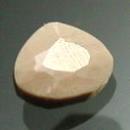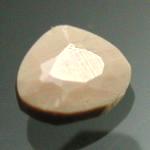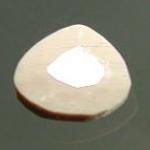|
|
||||||||||||||||
|
||||||||||||||||
|
||||||
|
|
|
|
Taranakite
|
|
| | |
| Discovered in 1865; IMA status: Valid (pre-IMA; Grandfathered) | ||
|
| ||
|
Chemistry |
|
|
| |
|
K3Al5(PO4)2(PO3OH)6 •18H2O | |
|
|
Hydrated Potassium Aluminum Phosphate Hydroxide |
|
Molecular Weight: |
1342.30 gm |
|
Composition: |
Potassium |
8.74 % |
K |
10.53 % |
K2O |
|
|
Aluminum |
10.05 % |
Al |
18.99 % |
Al2O3 |
|
|
Phosphorus |
18.46 % |
P |
42.30 % |
P2O5 |
|
|
Hydrogen |
3.15 % |
H |
28.18 % |
H2O |
|
|
Oxygen |
59.60 % |
O |
|
|
|
|
|
100.00 % |
|
100.00 % |
= TOTAL OXIDE |
|
|
|
||||
|
Classification |
|
|
| |
|
Phosphates | |
|
7/C.21-20 | |
|
|
8 : PHOSPHATES, ARSENATES, VANADATES
|
|
Related to: |
None |
|
Varieties: |
None |
|
Synonyms: |
Minervite, Palmerite |
|
|
|
|
Crystal Data |
|
|
|
|
|
Pseudohexagonal platy crystals, rarely to 0.5 mm; typically in compact nodular aggregates, pulverulent, powdery, flourlike to claylike, massive. |
|
|
None |
|
|
|
|
|
Physical Properties |
|
|
|
|
|
None |
|
|
None |
|
|
Malleable, unctuous (having a greasy or soapy feel) |
|
|
1.0 - 2.0 |
|
|
2.12 - 2.15 (g/cm3) |
|
|
None |
|
|
Barely Detectable; GRapi = 128.51 (Gamma Ray American Petroleum Institute Units) |
|
|
|
|
|
Optical Properties |
|
|
|
|
|
Gray, yellowish white, white; colorless in transmitted light |
|
|
Transparent, translucent, opaque |
|
|
n/a |
|
|
1.500 - 1.510 Uniaxial ( - ) |
|
|
0.006 - 0.007 |
|
|
n/a |
|
|
None |
|
|
|
|
|
Occurances |
|
|
|
|
|
Geological Setting: |
Formed from phosphatic solutions derived from bird or bat guano reacting with clays or aluminous rocks under perenially damp conditions in caves and along sea coasts; the most common phosphate mineral in caves. |
|
Common Associations: |
Vashegyite, Leucophosphite, Minyulite, Francoanellite, Brushite, Ardealite, Strengite, Variscite, Vivianite |
|
Common Impurities: |
None |
|
Type Locality: |
Sugar Loaf Islands, off Taranaki (now Port Taranaki), New Zealand |
|
Year Discovered: |
1865 |
|
View mineral photos: | |
|
|
|
|
More Information |
|
|
|
|
|
| |
|
|
|
|
Taranakite crystallizes in the hexagonal system and until 2009, was noted as having the longest crystallographic axis of any known mineral; the c-axis of the Taranakite unit cell is 95.05 Angstroms (9.505 nanometers) long. In 2009 however, Byzantievite was approved as a new mineral having a c-axis of 102.145 Angstroms (10.214 nanometers) long. Taranakite is also noted as being the first new mineral to be discovered in New Zealand. It was discovered in 1865 by Henry Robert Richmond (1829-1890), fourth superintendent of Taranaki, on the Sugar Loaf Islands of Taranaki, New Zealand. Taranakite was first analyzed and described by Scottish geologist Sir James Hector (1834-1907), and English analytical chemist William Skey (1835-1900). It was initially mistaken for Wavellite but was found to be a new mineral after analysis by Hector and Skey. James Hector was the first Director of New Zealand's Colonial Museum and Laboratory, with William Skey as its first analyst. Taranakite was later "rediscovered" in two cave locations and given two new names. In 1894, Armand Gautier described a mineral which he called "Minervite" from caves at Grotte de Minerve in Hérault, France and argued that it formed from decomposing guano and animal remains reacting with clays. In 1904 Eugenio Casoria found a mineral under a guano layer at Monte Alburno, Italy which he called "Palmerite" after Italian Professor Paride Palmeri, American Academy, Rome, Italy. These two minerals were later identified through X-ray powder diffraction as Taranakite and discredited in favor of Taranakite by historical priority. Taranakite
distribution:
from the Sugar Loaf Islands, near New Plymouth, Taranaki
Peninsula, New Zealand. On Réunion Island, Indian Ocean;
Island Leones, Patagonia, Argentina; King George Island,
Maritime Antarctic. In Australia, in the Russenden Cave,
Queensland; the Skipton lava tube caves, 40 km southwest
of Ballarat, Victoria; in caves at Mimegarra, Western
Australia; and the Jenolan Caves, New South Wales. In
the Yangsue Posayen Cave, 20 km south of Guilin, Guangxi
Province, China. From the Niah Great Cave, Sarawak,
Malaysia. In the Onino-Iwaya Cave, Hiroshima Prefecture,
Japan. From the Tour Combes Cave, near Oran, Algeria.
In Etienne’s Cave, and well-crystallized in Christmas
Cave, Transvaal, South Africa. From the Bacho Kuo Cave,
Bulgaria. In the Minerva Grotto, Fauzan, Hérault, France.
In Italy, in the Castellana Cave, south of Bari, Puglia;
on Monte Alburno, near Controne, Salerno. In the USA,
in the Pig Hole Cave, Giles County, Virginia; and the
Low Water Bridge Cave, Greene County, Missouri. Additional
localities are known. |
|
|
|||||||||||||||||||||||||||


